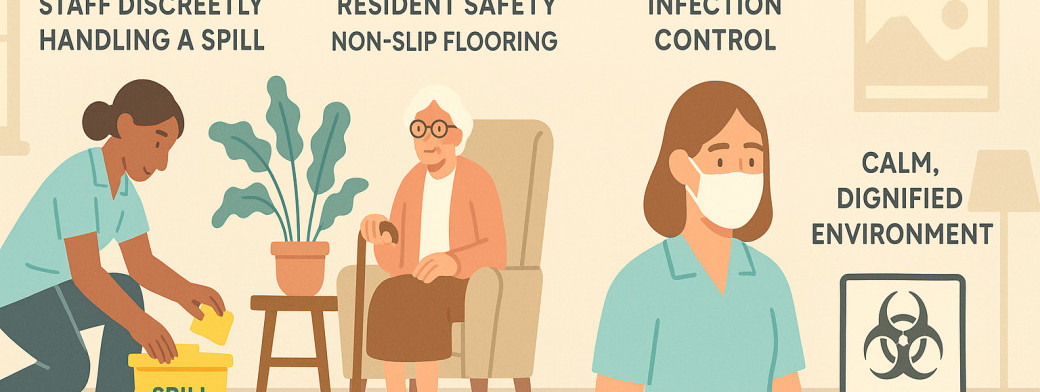
Spill Control in Care Homes: Safety, Dignity & Compliance
Context: Why Spill Control Matters in Care Homes
In the sensitive environment of care homes, ensuring the safety and dignity of residents is paramount. Spill control plays a crucial role in this regard. Effective management of spills protects vulnerable residents from slips and falls, minimises the risk of infection, and mitigates hazards associated with cleaning agents. Moreover, maintaining high standards of spill control is vital for upholding the reputation of care homes with both families and regulators.
Regulatory Backdrop
Care homes in the UK must navigate a landscape of regulatory expectations concerning spill management:
- HSE/COSHH Duties: Employers are required to assess risks and implement control measures for hazardous substances.
- Environment Agency Expectations: Proper disposal of chemical waste is mandatory to protect the environment.
- CQC Infection Prevention and Control (IPC) Standards: Care homes must adhere to IPC guidelines to prevent healthcare-associated infections.
- Adult Social Care Guidance: Best practices ensure safety and dignity for all residents.
Hazard Mapping
Identifying common spills and high-risk zones is essential for effective spill management:
Common Spills:
- Hot drinks
- Body fluids
- Cleaning chemicals
- Medicines
- Kitchen oils
- Lubricants from mobility equipment
High-Risk Zones:
- Resident rooms
- Bathrooms
- Corridors
- Lounges
- Kitchens
- Laundry
- Plant/boiler rooms
- Outdoor walkways
Controls
Implementing appropriate controls is essential for effective spill management:
- Colour-Coded Spill Kits: Align with cleaning standards for quick identification and use.
- Discreet Absorbent Packs: Ideal for public areas to maintain dignity and reduce the visibility of spills.
- Chemical Absorbents: Specifically designed for cleaning chemicals and medicines.
- Food-Safe Absorbents: Necessary for managing kitchen oil spills safely.
- Plant-Based Fibre Absorbents: Promote sustainability while effectively managing spills.
- Drain Covers: Essential in outdoor and plant areas to prevent contaminants from entering drainage systems.
- Bunded Storage for Chemicals: Prevent spills from occurring in the first place.
- Anti-Slip Floor Maintenance: Regular checks and maintenance to reduce slip risks.
Kit Strategy
A well-thought-out spill kit strategy enhances response effectiveness:
- Kit Placement: Position kits in public areas, sluice rooms, kitchens, laundries, and reception areas for easy access.
- Small Portable Kits: Equip care staff with portable kits for immediate response.
- Larger Kits: Designate for facilities teams handling significant spills.
- Signage and Staff Access: Ensure all staff are aware of the locations and contents of spill kits.
- Routine Inspection and Restock: Regular checks to maintain kit readiness and compliance.
Procedures & Training
Clear procedures and training are vital for effective spill management:
Standard Operating Procedures (SOPs):
- Body Fluid Spills: Prioritise infection control, appropriate PPE, disinfectants, and disposal methods.
- Chemical Spills: Follow segregation, signage, and containment protocols.
- Hot Liquids in Dining/Lounge Areas: Have a specific response plan in place.
PPE Selection:
- Ensure appropriate PPE is available and used during spill response.
Training Initiatives:
- Toolbox Talks: Regular discussions highlighting spill management practices.
- Refresher Training: Scheduled updates for all staff.
- Induction Training: Include agency staff and cleaners in spill response training.
Waste & Evidence
Proper management of waste and maintaining evidence is crucial:
- Segregation of Used Absorbents: Dispose of into clinical, chemical, or general waste streams as appropriate.
- Compliant Storage/Consignment: Adhere to regulations for hazardous waste disposal.
- Audit Logs: Maintain records of spills and responses for compliance checks.
- IPC Checks: Regular checks to ensure infection control standards are maintained.
- Photographic Evidence: Document spills and responses where appropriate.
Practical Tools
Equip staff with practical tools for effective spill management:
- One-Page Spill Response Checklist: Quick reference for care staff during spill incidents.
- Simple Flow for Spill Types:
- Body Fluid Spills: Assess, protect, clean, dispose.
- Chemical/Cleaning Spills: Contain, ventilate, clean, dispose.
- Kitchen/Oil Spills: Contain, absorb, clean, dispose.
Mini Case Vignette
Consider these two spill scenarios:
Scenario 1: Tea Trolley Spill in Resident Lounge
During afternoon tea, a trolley spills hot tea in the lounge, creating a slip risk. Staff swiftly activate the spill kit, placing signage around the area. They use absorbent materials to contain and clean up the spill, ensuring the area is safe. The rapid response maintains safety and reassures residents and families, demonstrating compliance with CQC standards.
Scenario 2: Disinfectant Spill in Laundry Area
A container of disinfectant spills in the laundry, posing a chemical hazard. Staff follow the SOP for chemical spills, wearing appropriate PPE and containing the spill with absorbents. They label the area and secure it until cleanup is complete. This careful management reinforces safety protocols and adherence to regulatory expectations.
FAQs
- How to manage spills without distressing residents? Use discreet absorbent packs and signage to alert staff while minimising disruption.
- Are universal absorbents safe for food areas? Ensure food-safe absorbents are used to prevent contamination.
- How often to train agency staff? Provide training at induction and refresher courses every six months.
- Where should spill kits be stored? Position kits in accessible locations such as lounges, kitchens, and laundry areas.
- How to record spill incidents for CQC? Maintain an audit log detailing the incident, response, and follow-up actions.
Conclusion
Effective spill control in care homes is essential for ensuring resident safety, dignity, and compliance with regulatory standards. By implementing robust procedures, training staff, and maintaining adequate resources, care home managers can create a safer environment for all.
For tailored spill management solutions, consider SERPRO's range of UK-approved products designed specifically for care homes. Take action today to enhance your spill management strategy and protect your residents, staff, and reputation.
